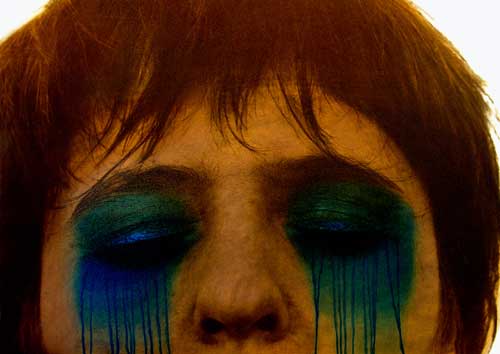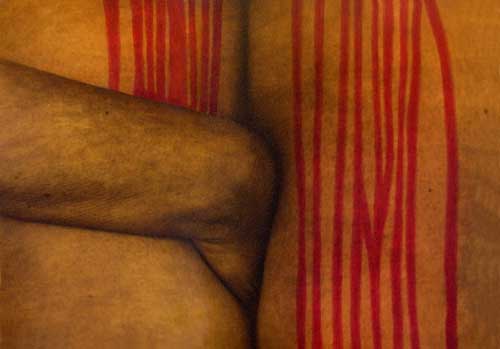



black & white photography hand coloured, 75x100 cm
Photoderms or the ambivalence of carnality
The body resembles a palimpsest on which experience and anguish are written down, emboldened by the unawareness of the subject who carries them. They cover the primal tissue of carnality with a sensual and sometimes even repulsive net of meanings every one of which is like a brand burnt on the skin with a sweltering hot iron. They may be shamefully hidden under a thick layer of powder and a forced smile - but those aspects of existence which are usually protected by an opaque curtain of shame, fear and insinuation may be also exposed.
Irena Nawrot's Photoderms present the body oppressed by the yoke of traumatic, destructive experiences. Unnerving, red traces on the skin, running mascara, blood. Hands frantically clenched in silent agony, a penetrating gaze desperately looking for help, persistently directed towards the viewer, or on the contrary - resignedly raised to Heaven, perhaps with a naive belief that this is where deliverance will finally come from.
We can realize how the latest photographs of Irena Nawrot differ from her earlier works when we compare the Photoderms series with her photographs from the 1990s, like, for example, the works from the series called Touch . At first glance their subject matter seems similar - the artist presents large close-ups of various fragments of her body: hands, eyes and thighs. Paradoxically, in spite of the fact that her carnality has been completely preserved, the abovementioned elements of her body gain a somewhat abstract form which makes such use of the surface of the skin as the painter of the paint - it is treated like a raw material. Minimalistic photographs that give the impression of infinite calmness and harmony which we find in Nawrot's earlier series are replaced by aggression and destruction which we never used to see in her works (although they had been heralded by certain elements in her previous realization - Self-portrait with Daughter ). It is difficult to find in them constant motifs of the artist's work, such as the element of water, traditionally connected with womanhood, vitality and fertility or the symbiotic relation of the body and other natural elements, like earth, feathers and stones. In Photoderms only the body is left - and it is by no means friendly, connected with sensual pleasure, but tortured and frustrating. If many of Nawrot's earlier works could be interpreted as an affirmation of the vital aspects of carnality, in this latest series the feeling of powerlessness and devastation dominates along with a strongly stressed motif of death which has been so trivialized in modern culture. Incidentally, this motif is nothing new in the artists's work. Subject matter connected with the sphere of Thanatos appeared more or less literally in many of her earlier realizations, but it was usually linked with the life-giving aspects of "eternal return". In Photoderms , however, the motif of death has been given such a strong and intense stigma of irreversible destruction for the first time.
The Photoderms series is unique also in a different respect. For the first time the artist not only colours her black-and-white photograhs - like in the earlier series of works - but also paints certain elements which had not existed in the initial reality of the image: makeup, red spots and blemishes on the skin or stripes of blood. In this way the boundary between photography and painting is erased. The photographs by Nawrot are but raw material, the starting point for further creative search. Here we arrive at one of the most important problems of the series, i.e. its multifaceted artistic ambivalence, present on many levels. The reality shown in these photographs by means of two overlapping media - first, photography which registers reality and second, various plastic manipulations that break down its literalism - gains the features of an object of purposefully conceived exploitation. The smeared makeup on the artist's face is not real, just like the traces of blood and fingers, blackened in deadly paralysis. But does this mean that the artistic message is weakened by means of such tricks? On the contrary - the painted elements thanks to their intentional artificiality perform the function of signs, hyperbolically, like in a lens that collects the whole spectrum of - usually drastic - acts and events which the defenseless body of a woman may be exposed to. Could we consider the traces painted directly on the artist's body instead of on the "ready" photograph as something closer to the truth? Does asking such a question in the discussion on art make sense at all - since art, as even its own name suggests, makes use of artificiality and convention? Photoderms are an ambiguous game with the viewer who is pulled into a sensual, paranoid world - a world which strongly affects him although the drastic elements are put in artistic parenthesis by means of the plastic manipulations described above. However, these are not parenthesis of irony and humour, like in the case of many postmodernist artists. We can feel the honesty and authenticity of the artist's message. The convention used is but a clearly marked territory of art which we accept with confidence - and like the acting of a devoted actor playing Hamlet moves us in spite of the fact that we know that we have to do with an unquestionable work of fiction.
The semantic ambiguity of Nawrot's works is contained in the situation of this aspect of the sign which is conceived as de Saussure's signifié and not comprehensively defined. Although Photoderms strongly suggest anguish and decay, they are situated at the thin borderline of meanings and effectively escape literalism which can be often observed in the works of women artists considered to represent the feminist tendency in art. The ring of reddened skin on the neck may be either a trace of a necklace which has been removed or a sign of torture, while smeared lipstick may suggest a passionate kiss. What about the drips of blood on the thighs? Is this the brand of cruelty or the natural blood of menstruation? Nawrot suggests a multitude of hints which the viewer may follow, but she does not point to any one of them explicitly, generating in this way an unsettling suspense in the sphere of semantic meaning.
The aforementioned ambivalence of Nawrot's latest series may be also observed on a purely aesthetic level. Neutral, black-and-white photographs after painting manipulations gain an unquestionably ugly character, emphasized by the intensely exposed carnality and sometimes also by the disharmony of colour. At the same time Photoderms supply the viewer with a specific aesthetic feeling in its primal sense, i.e. connected with sensory perception, not in the ordinary meaning of that word. They affect the viewer very strongly and draw his attention - especially by means of the use of intense, venomous colours - and in spite of their apparently repulsive character paradoxically contain a difficult to grasp kind of beauty which is the other side, the mirror reflection of the intensely exposed ugliness.
A question arises: who is this desperate owner of the maltreated body from Nawrot's works? The woman in the photographs is not the artist herself although she lends the heroine her carnality. The identification of the authoress with her work seems too easy, even though superficially speaking such an interpretation seems the most obvious choice. Nawrot embodies the archetypally drawn character of a mistreated woman and perversely authenticates her with her own body. In this way she conducts a subtle discussion with the function of the female body in our culture. Provocative makeup, meant to create desire, drips down her face, her fingernails are painted carelessly with pink polish and her skin instead of giving us pleasant aesthetic sensations emanates ugliness. It is difficult to reduce Nawrot's work to the narrow stream of feminist art but doubtlessly it is her specific female sensitivity that forms the fulcrum for her artistic activities.
Looking from a distance at the artistic output of Irena Nawrot one cannot help but acknowledge that she is an exceptionally conscious and consistent artist. Her interests concentrate around those phenomena that in today's "post-world", devoid of traditional sensitivity, have been branded as trivial, like pleasure, anguish and passing. However, thanks to Nawrot's creative impulse those seemingly devalued contents are given a new and surprisingly fresh meaning. Here and there her consciously kitsch style, filtered through the individual personality of the artist, gains specific meanings. In this way new senses are discovered and the viewer is drawn into the ambiguous space of Nawrot's works. This style is at the same time repulsive and overwhelming. It is intriguing.
Gabriela Jarzębowska

black & white photography hand coloured, 75x100 cm

black & white photography hand coloured, 75x100 cm

black & white photography hand coloured, 75x100 cm

black & white photography hand coloured, 75x100 cm

black & white photography hand coloured, 75x100 cm

Exhibition organized as part of an
OPERATIONAL PROGRAMME
"Art Promotion"
Copyright ©2006 Galeria FF ŁDK,Irena Nawrot, Gabriela Jarzębowska.